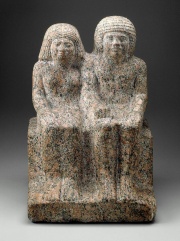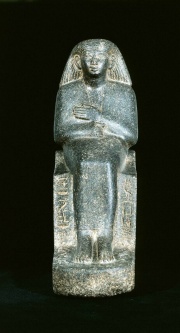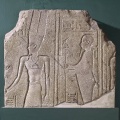Difference between revisions of "Granite"
m (Text replace - "== Authority ==" to "== Sources Checked for Data in Record ==") |
|||
| Line 1: | Line 1: | ||
| − | [[File:12.1488-SC6142.jpg|thumb|]] | + | [[File:12.1488-SC6142.jpg|thumb|Egyptian statues<br>MFA# 12.1488]] |
== Description == | == Description == | ||
A dense, hard, coarse-grain, mottled [[igneous]] rock. Granite is composed of silica ([[quartz]]) and silicates (chiefly [[orthoclase]] and [[albite]] feldspars). It may also contain small amounts of [[mica]], [[hornblende]], or [[augite]]. Granite is widely distributed over the world and is found to a great extent within most mountain ranges. The multicolored stone usually contains white and gray grains mixed with speckles of black, red, pink, yellow or green. Granite is difficult to carve, but is very strong, durable, and polishes to a high gloss. It is an important indoor (countertops, flooring, tables, decoration) and outdoor building stone (monuments, curbing, statuary). Granite is also used for paper mill rollers. | A dense, hard, coarse-grain, mottled [[igneous]] rock. Granite is composed of silica ([[quartz]]) and silicates (chiefly [[orthoclase]] and [[albite]] feldspars). It may also contain small amounts of [[mica]], [[hornblende]], or [[augite]]. Granite is widely distributed over the world and is found to a great extent within most mountain ranges. The multicolored stone usually contains white and gray grains mixed with speckles of black, red, pink, yellow or green. Granite is difficult to carve, but is very strong, durable, and polishes to a high gloss. It is an important indoor (countertops, flooring, tables, decoration) and outdoor building stone (monuments, curbing, statuary). Granite is also used for paper mill rollers. | ||
| − | [[File:1979.38-E13686CR-d1.jpg|thumb|]] | + | [[File:1979.38-E13686CR-d1.jpg|thumb|Statue of Tjutju<br>MFa# 1979.38]] |
== Synonyms and Related Terms == | == Synonyms and Related Terms == | ||
| Line 19: | Line 19: | ||
|} | |} | ||
| − | == | + | == Risks == |
Powder contains silica. Inhalation may cause silicosis. | Powder contains silica. Inhalation may cause silicosis. | ||
| Line 33: | Line 33: | ||
File:Granite.adamant2.p1.jpg|Granite | File:Granite.adamant2.p1.jpg|Granite | ||
</gallery> | </gallery> | ||
| − | |||
== Sources Checked for Data in Record == | == Sources Checked for Data in Record == | ||
| Line 51: | Line 50: | ||
* ''The American Heritage Dictionary'' or ''Encarta'', via Microsoft Bookshelf 98, Microsoft Corp., 1998 | * ''The American Heritage Dictionary'' or ''Encarta'', via Microsoft Bookshelf 98, Microsoft Corp., 1998 | ||
| − | * ''Encyclopedia Britannica'', http://www.britannica.com Comment: "granite" | + | * ''Encyclopedia Britannica'', http://www.britannica.com Comment: "granite" [Accessed January 22, 2002]. |
| − | * | + | * Marble Institute: http://www.marble-institute.com |
* C.W.Chesterman, K.E.Lowe, ''Audubon Society Field Guide to North American Rocks and Minerals'', Alfred A. Knopf, New York, 1979 | * C.W.Chesterman, K.E.Lowe, ''Audubon Society Field Guide to North American Rocks and Minerals'', Alfred A. Knopf, New York, 1979 | ||
Revision as of 10:34, 29 August 2020
Description
A dense, hard, coarse-grain, mottled Igneous rock. Granite is composed of silica (Quartz) and silicates (chiefly Orthoclase and Albite feldspars). It may also contain small amounts of Mica, Hornblende, or Augite. Granite is widely distributed over the world and is found to a great extent within most mountain ranges. The multicolored stone usually contains white and gray grains mixed with speckles of black, red, pink, yellow or green. Granite is difficult to carve, but is very strong, durable, and polishes to a high gloss. It is an important indoor (countertops, flooring, tables, decoration) and outdoor building stone (monuments, curbing, statuary). Granite is also used for paper mill rollers.
Synonyms and Related Terms
granit, granite (Fr.); granito (Esp., Port.); Granit (Deut.); graniet (Ned.)
| Mohs Hardness | > 5.5 |
|---|---|
| Density | 2.63-2.75 |
Risks
Powder contains silica. Inhalation may cause silicosis.
Additional Images
Sources Checked for Data in Record
- Ralph Mayer, A Dictionary of Art Terms and Techniques, Harper and Row Publishers, New York, 1969 (also 1945 printing)
- Dictionary of Building Preservation, Ward Bucher, ed., John Wiley & Sons, Inc., New York City, 1996
- Thomas C. Jester (ed.), Twentieth-Century Building Materials, McGraw-Hill Companies, Washington DC, 1995
- Anne Grimmer, Glossary of Building Stone Terms, A Glossary of Historic Masonry Deterioration Problems and Preservation Treatments, National Park Service, Washington DC, 1984
- Van Nostrand's Scientific Encyclopedia, Douglas M. Considine (ed.), Van Nostrand Reinhold, New York, 1976
- Random House, Webster's Encyclopedic Unabridged Dictionary of the English Language, Grammercy Book, New York, 1997
- The American Heritage Dictionary or Encarta, via Microsoft Bookshelf 98, Microsoft Corp., 1998
- Encyclopedia Britannica, http://www.britannica.com Comment: "granite" [Accessed January 22, 2002].
- Marble Institute: http://www.marble-institute.com
- C.W.Chesterman, K.E.Lowe, Audubon Society Field Guide to North American Rocks and Minerals, Alfred A. Knopf, New York, 1979
- Michael McCann, Artist Beware, Watson-Guptill Publications, New York City, 1979
- George Savage, Art and Antique Restorer's Handbook, Rockliff Publishing Corp, London, 1954
- CRC Handbook of Chemistry and Physics, Robert Weast (ed.), CRC Press, Boca Raton, Florida, v. 61, 1980 Comment: density=2.64-2.76







